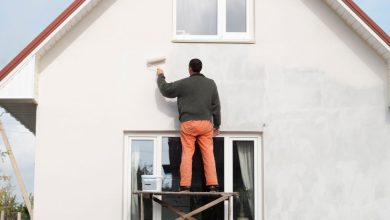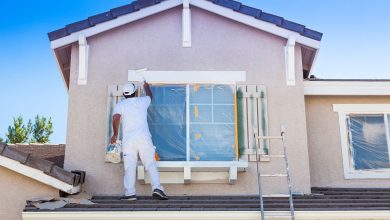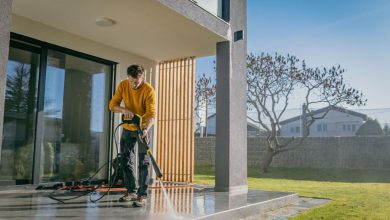How to Spray Paint House Exterior: A Step-by-Step Guide

Are you looking for a budget-friendly way to transform the look of your home’s exterior? Have you considered spray painting? You can achieve a professional-looking finish without breaking the bank with the right tools and techniques. In this step-by-step guide, we will show you how to spray paint house exterior like a pro.
Gone are the days of being stuck with the same old color on your home’s exterior. With spray painting, the possibilities are endless. Whether you want to add a pop of color, update your home’s style, or refresh a tired facade, this guide covers you.
We will walk you through each process step, from preparing your home’s exterior for the paint to selecting the right color and equipment. With our tips and tricks, you’ll be able to achieve a flawless finish that will make your home the envy of the neighborhood. Are you ready to tackle this DIY project? Let’s get started!
Equipment
To successfully spray paint the exterior of your house, you need to ensure that you have the right equipment for the job. The following is a comprehensive list of the tools you will need:
- A paint sprayer: This is the main tool you will use to apply the paint to the exterior of your house. It is important to choose a sprayer suitable for your project’s size and the type of paint you will be using.
- Masking tape: This will be used to cover any areas that you do not want to be painted, such as windows, doors, and trim.
- Drop cloths: These are essential for protecting the ground and any landscaping around your home from paint overspray.
- Paint: Obviously, you will need paint for this project. It is important to choose a high-quality exterior paint suitable for your area’s climate.
- Cleaning supplies: Before you begin painting, you will need to thoroughly clean the exterior of your house to ensure that the paint adheres properly. This will require soap, water, and brushes.
- A ladder or scaffolding: Depending on the height of your house, you will need either a ladder or scaffolding to reach all of the areas that need to be painted. It is important to choose a sturdy ladder or scaffolding suitable for your project’s height.
When spray painting your house’s exterior, there are a few key things to keep in mind. First, make sure that you wear protective clothing, including a respirator mask and safety glasses. It is also important to carefully follow the manufacturer’s instructions for your sprayer and paint to ensure the best possible results.
Preparation
Before beginning to spray paint the exterior of your house, it is crucial to prepare the surface to achieve the best possible results. Preparation involves several key steps, including removing any loose or peeling paint, thoroughly cleaning the surface, and covering any areas that you don’t want to get color on. By taking these steps, you can ensure that your paint job will look great and last for years.
To start the preparation process, use a scraper or wire brush to remove any loose or peeling paint from your painting surface. This step is important because the paint will not adhere properly if applied over old, flaking paint. Once you have removed any loose paint, sand the surface lightly to create a smooth, even surface for the new paint to adhere to.
Next, clean the surface of your house thoroughly. This can be done using a pressure washer or a simple water and soap solution. Remove any dirt, grime, or other debris accumulated on the surface. Allow the surface to dry completely before proceeding to the next step.
Once the surface is clean and dry, it’s time to cover any areas that you don’t want to get paint on. Cover windows, doors and other fixtures that require painting using masking tape. Ensure that you apply the tape securely and without any gaps or spaces where paint could seep through. It would also help to cover any plants or outdoor furniture with drop cloths to protect them from overspray.
Following these steps, you can ensure your house exterior is prepped correctly and ready for painting. Taking the time to prepare the surface will make a big difference in the quality of the finished product and will help your paint job last for years to come. So before you start spraying, make sure to take the time to prepare the surface properly.
Choose the Paint
If you want to give your house exterior a fresh coat of paint, choosing the right product for the job is important. Not all paints are created equal, especially for outdoor surfaces exposed to harsh weather conditions year-round. Therefore, it’s crucial to select a paint that is specifically formulated for outdoor use. This ensures that your efforts will not go to waste and that your paint job will last longer.
When selecting outdoor paint, it’s essential to choose a durable one that can withstand all kinds of weather, such as rain, wind, and sunlight. Look for a paint that won’t chip or crack easily and will remain vibrant over time. A long-lasting paint can save you time and money in the long run, as it won’t require frequent reapplication.
Also, remember to choose a color you’ll love for years. Consider the other features of your house, such as the roof, shutters, and landscaping, and choose a color that complements them. Trends and seasonal colors come and go, so choosing a timeless color you won’t tire of easily is better.
Spraying paint on a house exterior is a task that requires careful consideration. Selecting a paint that is specifically designed for outdoor use and durable enough to withstand weather conditions is important. Additionally, choosing a timeless color that complements your home’s other features is the key to a successful paint job. Keep these tips in mind for a beautiful and long-lasting painted exterior.
Start Spraying
It’s time to start spraying! To get started on spray painting the exterior of your house, grab your sprayer and hold it about 6-8 inches away from the surface you’re painting. Move the sprayer in a back-and-forth motion, making sure to overlap each pass by about 50%. This will ensure that you get even coverage on your surface.
It’s important to remember not to spray too close to the surface, as this may cause drips and runs. These can be difficult to fix and will ruin the finish of your project. It’s better to take your time and spray from a distance, covering the area evenly and with a light touch.
Don’t worry about not getting full coverage on your first coat. It’s always better to do multiple thin coats than one thick one. This will help you avoid clumps and drips, ensuring your project looks smooth and seamless.
With these tips in mind, you’re ready to spray paint the exterior of your house like a pro. Take your time, remember to overlap your passes, and be gentle with your sprayer. Before you know it, you’ll have a beautifully painted house that will envy the neighborhood.
Wait for it to Dry
Spraying paint on the exterior of your house can be daunting, but by following a few simple steps, you can achieve a professional-looking finish. Waiting for the paint to dry completely before applying another coat is one of the most important things to remember when spray painting. This usually takes a few hours, but checking the label on your color for specific drying times is always a good idea.
While waiting for the paint to dry, watching the weather is important. If there’s a chance of rain, waiting until the forecast is clear is best. Painting in wet or humid conditions can cause the paint to bubble and peel, ruining all your hard work.
Another factor to consider is the temperature outside. Most paints are best dry between 50 and 85 degrees Fahrenheit, so avoid spraying in extreme heat or cold. If you need clarification on the temperature, check the label on your paint or use a thermometer to measure the air temperature.
Once the paint is completely dry, apply another coat if necessary. It’s important to build up the layers of paint slowly instead of trying to cover everything in one go. This will help prevent drips and ensure a smooth and even finish.
Apply Second Coat
To properly spray paint the exterior of your house, it’s important to apply a second coat after the first has dried. Applying a second coat is a crucial step for achieving a professional-looking finish.
First, ensure the first coat is completely dry before starting the second coat. Typically, it takes around 24 hours, but it’s important to check the manufacturer’s instructions for the paint you’re using to ensure it fully dries.
Once the first coat is dry, it’s time to apply the second coat. Follow the same process as before, starting at the top of the house and working your way down. Ensure that you overlap each pass with the spray gun to apply the paint evenly and avoid any missed spots.
When applying the second coat, use long, even strokes and hold the spray gun at the same distance from the surface as you did with the first coat. This will help to ensure an even application of paint and reduce the risk of drips or runs.
The second coat should provide full coverage and a flawless finish for your house. Depending on the type of paint used, the surface’s condition, and how many coats you’ll be applying, you may apply a third coat once the first two coats have dried.
Applying a second coat of paint is a crucial step when spraying the exterior of your house. By following the same process, ensure you use the paint evenly and avoid missed spots. With the second coat applied, your home will have full coverage and a smooth finish that will look great for years.
Clean Up
Congratulations on completing your exterior house painting project! Now, it’s time to clean up all the tools and materials used. To begin, it is important to clean the sprayer you use properly. Thoroughly rinse the sprayer with clean water, removing leftover paint from the container, hose, and nozzle. Doing this will ensure that the sprayer is ready for its next use.
Additionally, it is crucial to dispose of any leftover paint properly. You can donate the paint if it’s still in good condition or take it to a hazardous waste facility to dispose of properly. Avoid pouring leftover paint down the drain or into the trash, as it can harm the environment.
When cleaning up after a spray painting job, it’s also important to clean up any overspray or paint drips on the surfaces surrounding the area you painted. Use a damp cloth to wipe down any areas where paint may have landed gently.
In summary, cleaning up after a spray painting job is an important step to ensure the longevity of your equipment and protect the environment. By following these tips, you’ll be ready to tackle your next painting project with confidence and ease.
Enjoy Your New Look
Congratulations! You’ve successfully transformed the exterior of your home with minimal cost using spray paint. Take a moment to step back and admire the fruits of your hard work. It’s incredible how a simple change can completely transform the entire look and feel of your home.
Now that you’ve completed the project, it’s time to sit back and enjoy your beautiful new exterior. You can take pride knowing you did it all and saved much money.
Painting your home’s exterior may seem daunting, but it can be straightforward. With the right tools and techniques, you can achieve professional-looking results lasting for years.
First, choose the right type of paint for your particular surface. The type of paint you use will depend on the material of your home’s exterior, such as stucco, brick, wood, or metal. Always read the product labels carefully to ensure you choose the right paint for your project.
Next, gather all the necessary tools and supplies, including a spray paint gun, paint, primer, sandpaper, masking tape, and drop cloths. Wear protective clothing and eye gear to avoid accidents or injuries.
Before spraying, thoroughly clean the surface you’ll be painting. This will ensure that the paint adheres properly and creates a smooth finish. Use sandpaper to remove any old paint, rust, or debris, and then apply a coat of primer to help the paint adhere.
When you’re ready to begin painting, use the spray gun to apply several thin coats of paint, allowing each coat to dry completely before applying the next. Be sure to use a steady and consistent motion to ensure even coverage. Use masking tape and drop cloths to protect areas you don’t want to paint.
In no time, you’ll have a beautiful new exterior for your home that will leave your neighbours amazed. With your new look, you’re sure to enjoy spending more time outdoors, entertaining guests, and relaxing in your home.
Conclusion
In conclusion, spray painting is a great option if you want to refresh your home’s exterior. With the right tools and preparation, the process can be straightforward, and the results are stunning. Whether you’re looking to increase your home’s curb appeal or want a fresh new look, spray painting is a great DIY project that can save you money and give you a sense of accomplishment.
So, how to spray paint house exterior? First, you’ll need to ensure you have the right equipment, including a high-quality sprayer and paint designed specifically for outdoor use. You’ll also want to prepare your home’s exterior by cleaning it thoroughly and masking off any areas you don’t want to paint. Finally, it’s important to take your time and apply the paint evenly, ensuring a smooth and beautiful finish.
Overall, spray painting your home’s exterior is a great way to give it a new lease on life. With the right tools and preparation, you can achieve professional results that will make your home the envy of the neighbourhood. So why wait? Spend a little money today on spray paint and have a great new look for your home. With this DIY paint project, you’ll get a beautiful new look that will last years.




